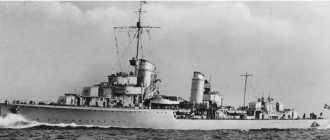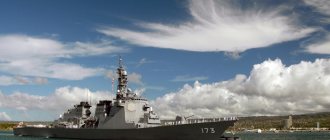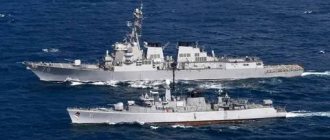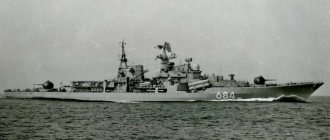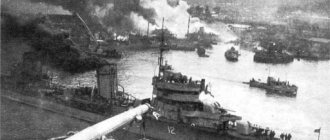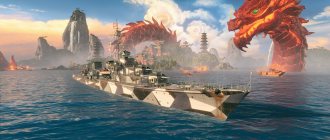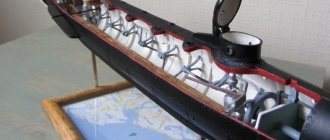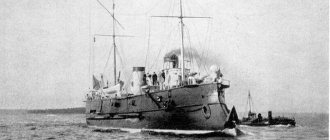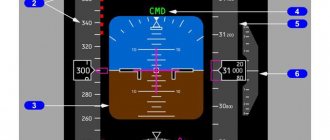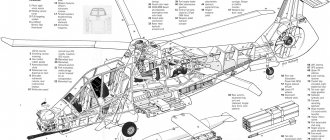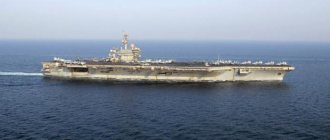USS Zumwalt (DDG-1000) is removed from dry dock on 10/28/2013. On October 28, 2013, an event occurred in the United States that had long been expected by military sailors, as well as by many journalists from around the world - a ship, which was promised an unusually successful future even before the start of its construction, was launched from the stocks. She was the "21st century destroyer" USS Zumwalt , named after Admiral Elmo Russell Zumwalt. The new ship from the very beginning became a real “press star”, since it had an extremely unusual appearance, standing out sharply against the background of the Arleigh Burke-class destroyers that had already become familiar. It seemed that the United States had managed to make another “breakthrough into the future” by building a truly revolutionary ship. But it soon turned out that the Zamvolt had so many shortcomings that they could well not only outweigh its advantages, but also make the project of the “destroyer of the 21st century” itself a colossal failure.
History of creation
At the end of the 1980s, the US Navy still had several battleships remaining. These huge ships were already considered obsolete at that time, but they were in no hurry to be written off. The American naval command valued the battleships mainly because they were armed with Mark 7 . A shot from such a cannon was disproportionately cheaper than launching a cruise missile, and the projectile, weighing on average 1225 kilograms, caused terrible damage to any coastal objects, and in most cases simply destroyed them.
But time is merciless - it was impossible to extend the service life of battleships indefinitely, and they had to be replaced by some other ships with the same capabilities. In addition, the military command was not entirely satisfied with the fact that the Mark 7’s range was only 48 kilometers.
The battleship New Jersey fires all nine main guns.
In 1989, the command of the US Navy came to the conclusion that the Cold War was over, and therefore previous plans to create new ships (in particular, the SOCS and SCFRS research programs) were outdated. To ensure that the developed ideas did not go to waste, as well as to maintain the previous volumes of funding for research work, the main efforts were transferred to the creation of “substitutes for battleships.” The new ships, like the old giants, were supposed to provide fire support for landing operations and destroy ground targets using both cruise missiles and powerful artillery guns.
As a result, in 1992, the SC -21 (Surface Combatant 21 Century, that is, “surface combatant of the 21st century”) was launched. It was assumed that its result would be the appearance of ships that could no longer be classified as “traditional” classes. Their displacement could vary within very wide limits - from 2,500 to 40,000 GRT. As part of this program, four main concepts were studied, one of which involved the creation of a multi-purpose ship tentatively called Littoral Combatant (“coastal fighter”). Generally speaking, the then chief of naval operations, Jeremy Boord, was much more interested in the Arsenal project, armed with five hundred cruise missiles, but in 1996 the admiral shot himself after learning that he was wearing an award that was not due to him.
After the change of command, Littoral Combatant began to come to the fore. It was renamed first to Power Projection Ship, and then to DD-21 (Destroyer 21 Century, “ destroyer of the 21st century ”).
Estimated appearance of the Arsenal ship.
The basic technical requirements for this ship were developed gradually, starting around 1997. Some of them were "inherited" from the old SOCS research program, others from the failed Arsenal project. In general, the list of these requirements looked something like this:
- All ship systems, including the engines driving the propellers, are electric. Because of this, it was necessary to install powerful generators on board that could generate enormous amounts of energy. The idea was “inherited” from the SOCS program.
- Maximum level of automation, minimum number of crew members.
- The command room (bridge) and Combat Information Center are located in a common room in the “deep ship” to reduce vulnerability - also part of the SOCS program.
- The housing must have as small an effective surface area for reflecting radio waves as possible. In this part, developments from the Arsenal ship project were used.
- The main weapon is cruise missiles placed in vertical launch systems, the secondary weapon is 155 mm artillery guns with a range of at least 117 km.
It was initially assumed that the “destroyer of the 21st century” would be able to carry up to 256 Tomahawks. In addition, they wanted to equip it with a promising VGAS artillery mount with a “vertical launch” system. It quickly became clear that this plan was unrealistic - they preferred to place the guns in conventional rotating turrets.
In 2001, the design of the lead ship DD -21 , for which the name Zumwalt had already been chosen, had to be seriously revised because the US Congress cut funding for the program by about 50%. As a result, the future destroyer began to be designated in official documents as DD (X).
Ground testing of the gun mount for the Zumwalt destroyers.
Even then it became clear that the initial plans of the fleet , which included the construction of thirty-two such ships, would not be implemented due to their enormous cost.
During negotiations with congressmen, representatives of the fleet agreed to reduce the initial order first to 24 destroyers, and then to seven, but no agreement could be reached until December 2005, when the Senate and House of Representatives nevertheless “gave the go-ahead” for further funding of the program. At the same time, the allocated funds were enough for the construction of only one ship, which was supposed to become a “technology demonstrator.”
Subsequently, the fleet itself clearly lost interest in the new type of destroyers. After studying the reports of a number of experts, the Navy command came to the conclusion that the Zumwalt is poorly protected from anti-ship missiles and air attacks. Therefore, in 2008, when the program had already been renamed again, this time to DDG -1000 , Navy representatives in Congress stated that they would prefer to order eight additional Arleigh Burke-class destroyers instead of building ships of the Zumwalt class. But by this time, more than 10 billion dollars had already been spent, and therefore they did not abandon the program halfway through. It was decided to complete the construction of the lead ship, and then two more new destroyers. As a result, the overall cost of the program decreased, but the estimated cost of each ship rose to almost six billion dollars in 2009, which was more than 80% higher than the originally planned costs, even taking into account inflation.
The construction of the destroyers was entrusted to two companies - Bath Iron Work and Northrop Grumman Shipbuilding. The official launch date for serial production of the ships was February 11, 2009. About two years later, the lead destroyer, USS Zumwalt, was laid down at a shipyard in Maine.
Construction of the destroyer Zumwalt.
By this time, the ship's design had already been worked out in detail, and therefore construction was completed relatively quickly. However, more than two years passed from launching to the first test trip to sea, which took place in December 2015.
The second ship in this series, DDG-1001, named USS Michael Monsoor , was launched in June 2016, when the lead destroyer had already been accepted into the US Navy. Currently, the US Navy operates both of these ships, and the third, DDG-1002, USS Lyndon B Johnson , was supposed to take place last year, but for some reason it was postponed.
Perspective
As was already written earlier, at the time of development of the DDG 1000 project, it was planned to build a fairly large series of these ships of 32 pieces, then the program was repeatedly adjusted, the cost of one production ship increased from 750 million dollars to 2.2 - 2.7 billion dollars ( according to the Pentagon's plans, and it was decided to reduce the entire series first by half, then to seven, finally in August 2008. US Senator from Maine Susan Collins at a meeting of the Armed Services Committee announced that US Navy Commander Donald Winter shared with her the decision to build a new third ship, although a month before it was reported that only the first two ships had been completed. One way or another, it is now clear that the project is far ahead of its time, even in financially prosperous America its cost and necessity are causing a lot of controversy. In fact, the ship is being born in an era when there will simply be no rivals for the foreseeable future. For an obsession with the fight against terrorism, it looks like an unaffordable luxury. In any case, you can be sure that the ships already laid down will be completed, America is not used to throwing away the money of its taxpayers, which means that we will soon see the ship in trouble, and the correctness or incorrectness of the decisions invested in it, time will tell.
—————
Main design features of the “destroyer of the 21st century”
The Zumwalt cannot be confused with any other ship because its hull has a very distinctive shape: the sides are “tilted back” at an angle of about eight degrees from the waterline. The stem has an even more significant reverse slope of 45 degrees. Such a building in English-language sources is designated as tumblehome, which literally translates as “overturned house.”
A similar hull configuration was sometimes used before - for example, on the cruiser Aurora, the front part also has a reverse slope, although not as pronounced. At the turn of the 19th-20th centuries, the “overturned” bow was used to increase seaworthiness and simplify navigation when passing through narrow channels, but for the creators of the Zamvolt something completely different was important - they sought to minimize the radar signature of the destroyer. That is why its body was made in accordance with the requirements of the “ stealth ” technology already used in aircraft construction by that time.
Superstructure of the destroyer Zumwalt.
The most visible part of the destroyer is the huge superstructure , which contains radar, antennas, a bridge, a mast, various electronic equipment, and a hangar for an air group consisting of three MQ-8 Fire Scout unmanned aerial vehicles and one SH-60 helicopter The take-off platform for them is located at the stern of the ship.
The bow deck is noticeably longer than the stern deck. It houses two AGS artillery mounts. The shape of the towers also takes into account the requirements of stealth technology.
The superstructure on the lead ship USS Zumwalt is made of composite materials and balsa (a very light and strong wood). These same materials completely cover the outer surface of the main hull with a layer approximately an inch thick. This solution, combined with the “reverse tilt” of the sides and stem, made it possible to reduce the size of the effective reflective surface to such an extent that, in terms of its radar signature, the destroyer differs little from a small fishing boat.
At the same time, however, the superstructures of the second and third ships in the series were made of ordinary steel in order to save costs. Of course, such a simplification largely contradicts the very concept of a stealth ship.
The “destroyer of the 21st century” does not have armor in the usual sense of the word. Kevlar is used to protect the most important elements of on-board equipment and ammunition.
Seven billion, Karl!
Back in May 2016, the author of the blog “Great Russia” Mikle1 warned that the new American “iron” would be of no use.
“The iron has disgusting seaworthiness, the bottom has no mine protection, and there is no armor as such. The cabin, you won’t believe it, is making its way out of Makarov. According to some reports, it is generally made of wood. That is, it is also on fire,” the blogger wrote.
“The American Zumwalt iron has broken down again. Now, without power, it is stuck in the Panama Canal,” Mikle1 responded to the latest news about the ill-fated destroyer. — Yes, you understood everything correctly: the “very, very” high-tech destroyer of the US Navy, Zumwalt, once again failed the expectations of the admirals. However, the developers are least concerned about this, because they have already received their 7 (seven, Karl!) billion dollars for the “carcass”. Some kind of Trojan horse, not a destroyer. And yes, it’s made of wood.”
On-board equipment
To actively search for targets, Zumwalt-class destroyers were initially supposed to be equipped with two main radar stations. The first of these is the AN/SPY-3, the first American shipborne radar The second radar was supposed to be the AN/SPY-4S decimeter range, but in 2010 it was decided to abandon it in order to reduce the price of the destroyer.
Locations for installing the radar (shown by red arrows).
As a result, the ship's anti-aircraft capabilities were noticeably reduced. Although “according to the passport” the target detection range using the AN/SPY-3 is almost 400 km, in practice guaranteed target designation for anti-aircraft missiles is provided at just over 50 km.
To search for submarines and sea mines, the following equipment is installed on board the Zumwalt:
- Sonar SQS-60. Works at medium frequencies.
- Sonar SQS-61. Operates at high frequencies.
- AN/SQR-20 is a complex consisting of a control system, an antenna array that is towed behind the ship and a multifunctional sonar.
Data collected by radars, sonars and various sensors is fed into an onboard computer network called The Total Ship Computing Environment Infrastructure (TSCE or TSCEI). The network includes 16 main computers running an operating system that is a special variant of Linux.
combat information center is equipped with numerous monitors and resembles a spacecraft mission control center rather than a conventional ship's control bridge. This room itself is made very spacious.
In addition, Zumwalt is equipped with fire extinguishing systems, numerous video cameras and control devices. All this equipment is as automated as possible.
What are you dreaming about, cruiser?
“As a result, we have a super-expensive large iron that emits a “shoot at me” signal with all its antennas, does not have effective air defense systems and carries old cruise missiles as its main weapon,” Mikle1 writes about Zamvolta.
And here are some more jokes about the unlucky “wunderwaffle”:
“Now the Americans will have their own Aurora.” “It will be easy for Russian special forces to climb this hill along the inclined side.” They'll run up. - So this is a floating ziggurat! “Judging by the cost, the gold was poured into it just right.” - *Pityingly*: what a terrible thing. — The American military is just a training ground for testing technologies; a hot and real war seems to be the last thing they think about there. - Well, let them cut their defense budget, not ours. — In my opinion, this Zumvalt is a waste of money. Let me explain. A destroyer at the price of a nuclear submarine is too much. In short, the Americans seem to have surprised themselves again. And for such “wunderwaffles” we have “Caliber”, which does not care about high technology. “The stone flower didn’t come out—it turned out to be a huge, ugly floating collection of military-technical disgraces.”
For reference : “wunderwaffle” is a contemptuous name for military equipment that claims to be innovative, but is usually not developed or developed very poorly. The word comes from the German "wunderwaffe" - a term coined by the Ministry of Propaganda of Nazi Germany as the name for the "miracle weapon" of the Third Reich.
Power point
The electrical energy required to operate the onboard equipment of the “21st century destroyers” is generated by two Curtiss-Wright generators, which are connected to Rolls-Royce MT30 gas turbine engines. The power of each of them is 47,500 hp. (35.4 MW). In addition, the power plant includes two Rolls-Royce RR4500 auxiliary turbogenerators with a power of 3.8 MW each
Diagram of the USS Zumwalt combat information center.
The propellers are driven by AIM asynchronous electric motors manufactured by Converteam. Initially, it was planned to use quieter and lighter synchronous motors with permanent magnets from DRS Technologies.
The total power of the power plant is 105,000 hp, that is, 78 MW. The total electricity consumption (excluding electric motors) is approximately 20 MW. Theoretically, this makes it possible to place on board various laser systems or, for example, a railgun.
Destroyer armament
The main “highlight” of the DD-21 project was once considered to be the Advanced Gun System Mark 51 , capable of firing up to ten 155 mm caliber shells within one minute, hitting targets located at a distance of 140 to 190 km (according to various sources). Most often it is stated that the maximum range is 154 km.
Of course, a conventional artillery shell is not capable of flying that far, especially with the required accuracy (the permissible circular probable deviation is 50 m). Therefore, special ammunition known as LRLAP (Long Range Land Attack Projectile) was developed for the Mark 51. They were essentially guided missiles rather than projectiles. With a total LRLAP weight of 102 kg, its warhead contained approximately 11 kilograms of explosives.
Due to the fact that such shells were manufactured exclusively for the Zamvolts, and in small quantities, their price eventually rose to eight hundred thousand or even a million dollars, which is comparable to the cost of the much more powerful and long-range Tomahawk missile. The navy considered this unacceptable and refrained from concluding a supply contract. As a result, ultra-modern guns were left without ammunition. It turned out to be impossible to use conventional shells to fire them.
Drawing depicting an LRLAP projectile in flight.
Thus, guided missiles became the main weapon of Zumwalt-class destroyers. The ship can use the following types of these ammunition:
- BGM -109 Tomahawk . A long-range cruise missile (up to 1,700 km with a “conventional” warhead), designed to destroy various ground targets with previously known coordinates. The flight is carried out according to the electronic map of the area and GPS system data.
- RUM-139 VL-ASROC. A vertically launched missile whose warhead is a homing anti-submarine torpedo . An approximate analogue of the Soviet Vodopad missile-torpedo system. Flight range is up to 22 km (for “Waterfall” this parameter can reach 50 km).
- RIM-162 Evolved SeaSparrow Missile ( ESSM ). A missile for destroying air targets. Range – up to 50 km, flight speed – up to 4M.
To deploy missiles, “peripheral” (that is, located directly on the sides) Mk 57 VLS . There are twenty of them in total, with four cells in each. One cell houses either one Tomahawk , one RUM-139, or four ESSMs. The length of the Mk 57 installation cells is increased compared to the Mk 41 , which is equipped with the Arleigh Burkes, which means that over time, larger and more powerful ammunition with an increased range may appear on board the Zamvolt.
In 2022, it was reported that, along with the Tomahawk, Zumwalt-class destroyers are capable of using the modern AGM -158 C LRASM (Long Range Anti-Ship Missile) anti-ship missile. Thus, it will be possible to hit surface targets, which was previously absent.
Aviation version of the AGM-158C LRASM missile on a transport trolley.
The declared range of this missile is 1000 km, but it is not entirely clear how exactly target designation will be carried out. The flight speed is subsonic, and this is the main disadvantage of the rocket.
In addition, in the fall of 2022, test launches of the SM-2 anti-aircraft missile were carried out from the USS Zumwalt, which is part of the standard armament of Arleigh Burke-class ships, carriers of the well-known Aegis missile defense/air defense system . Previously, such missiles were incompatible with the electronic equipment of the “destroyer of the 21st century.” Especially for Zamvolt, American engineers developed a special modification - SM-2 Block IIIAZ.
Defensive weapons, intended primarily for the destruction of high-speed, highly maneuverable targets (for example, boats) “at the last line,” consist of two 30-mm automatic cannons . Their range is about four kilometers. According to the project, other guns were to be installed on the ship - 57-mm Mk 110, capable of hitting targets at distances of up to 17 km, but during ground tests these guns could not confirm their characteristics. Navy officials say the actual effective range of the Mk 46's guns is no more than one mile (1,854 m), making the ship quite vulnerable to attack from fast boats.
The media have repeatedly reported that a railgun or powerful laser systems may appear on board Zumwalt-class destroyers. Back in the 80s, these types of “weapons of the future” were planned to be installed on a hypothetical “SOCS ship”, from which the Zamvolt inherited many of its characteristic features. Conversations about a railgun especially intensified after it became clear that the destroyer's 155-mm guns would not receive ammunition. However, no real steps have been taken in this direction so far.
Ground testing of a prototype naval railgun.
As a matter of fact, the railgun project is another attempt to get a long-range weapon with cheap ammunition instead of guided missiles. But testing of prototypes revealed such a wide variety of problems that could not be solved at the technological level available today that these weapons had to be temporarily forgotten.
Project evaluation
The entire history of the creation and construction of “ships of the future” is a chain of forced compromises, caused mainly by overspending of financial resources. Statements that the Zamvolts will allegedly become the basis of the American navy of the 21st century, appearing from time to time in various media, look rather ridiculous, considering that only three ships have been built, and there are no plans to lay down new ones.
The main failure of the project, of course, was the refusal to use 155-mm guns, for which everything was initially started. As a result, the ship, originally intended for fire support of landing operations, had to be reoriented after its introduction into the fleet to solve a completely different task - combating enemy surface vessels. At the same time, the deployment of LRASM missiles necessary for this on board has not yet been officially announced.
The first two Zumwalt-class destroyers commissioned by the US Navy.
In addition, the meaning of using the widely advertised “stealth” technology is still not clear. How stealth can help such a ship is unclear, especially since immediately after turning on the radar or launching a missile, the destroyer will inevitably give itself away.
Another weak point of the Zamvolt is its radar. Due to the fact that the decimeter range radar was abandoned, long-range detection has become problematic, and target illumination for missiles is carried out only at medium distances. As a result, the ship can potentially protect itself from incoming anti-ship missiles, but that’s all. Defeating enemy aircraft and missiles at long distances is only possible with external target designation. In addition, Zumwalt is not able to interact with the Aegis system, which also limits its capabilities.
In terms of ammunition size, the “ship of the 21st century” is more than one and a half times smaller than Arleigh Burke-class destroyers, which carry up to 128 Tomahawk missiles. For some time, the media circulated the version that the Mk 57 VLS could be used to launch hypersonic missiles, but it later turned out that the dimensions of this promising weapon are too large even for the elongated cells of the Zamvolt’s peripheral vertical launch systems.
All these facts, as well as numerous reports of various breakdowns of the new destroyers, became the reason for ridicule of the ultra-expensive ships, which turned out to be less effective than their relatively cheap predecessors. Zumwalt began to be called a classic example of a “suitcase without a handle” - it’s a shame to throw it away, but it’s unclear how to use it.
Peripheral vertical launch installations Mk 57.
Such a dismissive attitude towards these ships is hardly justified. Indeed, one cannot count on the fact that three Zamvolt-class destroyers will radically strengthen the American fleet. But a number of new technologies have already been successfully developed on these ships, which will undoubtedly find wide application in the future. After all, this is not the first precedent of this kind. The American Army did not receive any Valkyrie bombers, Comanche helicopters, or OICW assault rifles, but all these projects left behind a rich legacy that was used in more successful weapons.
Performance characteristics
The most important parameters of Zumwalt-class destroyers are as follows:
| Ship length | 183 m |
| Width | 24.6 m |
| Draft | 8.4 m |
| Displacement (total) | 14,797 metric tons |
| Power plant power | 105,000 hp |
| Maximum speed | 30 knots |
| Crew | 148 people |
As is easy to see, in terms of its displacement and size, the ship roughly corresponds to heavy cruisers of the Second World War, and not to destroyers at all.
Sea Jet
The development program for the promising destroyer included the creation of a large-scale 50-meter self-propelled model of the AESD demonstrator with a displacement of 120 tons, called the Sea Jet. The entire demonstrator project was funded by the ONR Center for Naval Research. On August 24, 2005, an official ceremony was held to mark the start of testing work in the city of Bayview on Lake Pend Oreille. The Sea Jet is equipped with diesel generators and batteries for silent operation during acoustic measurements, and has two electric propulsion motors. Full speed on diesel engines is 8 knots, and on batteries 16. At different times, two different rudder-propeller complexes were tested as propulsion systems, first there were maneuverable and economical AWJ-21 water cannons designed to improve the maneuverability of the ship in shallow water and improve acoustic stealth, and later the latest rudder propellers with permanent magnet electric motors were installed. RIMJET is a development of General Dynamics Electric Boat, which uses a submersible electric motor-propeller with a stator in a ring attachment and a rotor located at the ends of the propeller blades. According to GD Electric Boat, this option has greater torque at low speeds, better propeller efficiency due to a small core, smaller size and weight of the entire column, a high cavitation threshold due to the operation of the screw at low speeds and preventing the formation of vortex flows using a ring nozzle. However, the model served not only for testing in the field of electric propulsion, but also for measuring physical fields; for this purpose, the aluminum superstructure of the model was replaced with a superstructure similar in shape and size, but made of radio-absorbing composite materials.
